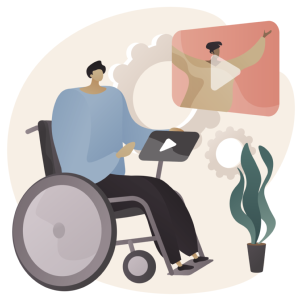
Many apparent and non-apparent disabilities can impact mobility. Disabilities like loss of limb, paralysis, arthritis, multiple sclerosis, and many more can affect mobility and make it difficult to use some technologies in the workplace. However, as the tip sheet from AccessATE and DeafTEC discusses, this does not mean that people with these disabilities cannot do the same work at the same quality as employees without disabilities. Like all employees, those with physical disabilities just need the right tools – let’s dive deeper into some specific accommodations that enable operation of technology!
Tip Sheet: Workplace Accommodations for Physical Disabilities
Some of the simplest options for accommodating employees with physical disabilities are related to keyboards and computer mice. A very common iteration of this is keyboard-only navigation, which is a straightforward alternative for those whose disability makes it difficult to use a mouse. Keyboard-only navigation is compatible with any standard keyboard, and is more about the accessibility of the software than the hardware, so it’s always wise to ensure that your company’s software is keyboard-navigation compatible! (Keyboard-only navigation can also be useful for users without disabilities, who may leverage the faster access it provides to increase their productivity.)
There are also a number of specialized keyboard options for those who can only use the keyboard with one hand or those for whom a standard keyboard is difficult to use. These include, but are not limited to, compact or large keyboards, keyboard guards, chording keyboards, or on-screen keyboards. When it comes to computer mice, there are alternative options, too: vertical mice, large trackball mice, bar mice, even foot mice! For some disabilities, a simple change of keyboard and/or mouse will be enough for the employee.
For some employees with disabilities, circumventing the conventional keyboard-and-mouse setup is better. In some cases, this can be achieved with simply swapping them out for a touchscreen, or for switch devices, which are buttons that enable the user to select options from a grid that gradually narrow to the desired option. However, some disabilities may involve more unique and specialized equipment – allowing the employee to operate without the use of their hands! There are many of options for this kind of accommodation.
One such option is the use of the mouth; some people with disabilities utilize a mouth wand (sometimes called a mouth stick) to type on a normal or specialized keyboard. Others use joysticks operated with the mouth, which, paired with an on-screen keyboard, provides full access to all computer functions. Best of all, many of these joysticks are “plug and play”, easy to set up and get working quickly! Similarly, there’s equipment that allows for the operation of technology using movements of the head to control the cursor. This can be done with a wearable headset, or tracked with a camera. There are also options for using the feet, such as feet mice (mentioned above), or those that substitute both keyboard and mouse like the SoftStep.
For employees with especially limited mobility, there are options that enable the use of computers and other technology without having to touch any equipment at all. Many of us know and love (or have a complicated relationship with) voice-activation software like Siri or Alexa. The voice recognition technology behind these common conveniences has gone beyond mere speech-to-text or dictation – specialized software allows for more complex commands, like formatting documents and pages, and web browsing. This technology is helpful not only for physical disabilities, but can also help bypass issues with spelling or grammar for those with disabilities like dyslexia. Another option for people with very limited mobility is eye tracking, which tracks the movements of the eyes across a screen using a camera. Selections are made by lingering on a location or by blinking, depending on the settings. Eye tracking can be used to control programs, to navigate similarly to using a mouse, and to type on an on-screen keyboard.
There are myriad options for accommodating physical disabilities in the workplace. No matter the level of an employee’s mobility, there exists one or more technologies that empower them to do their jobs just as well and efficiently as their peers without disabilities.
Additional Resources
- Better Living Through Technology has a great article, Keyboards for People with Disabilities, with many examples of alternative keyboards for disabilities. Additionally, check out Keyboard and Mouse Alternatives and Adaptations for a rich list of accommodation equipment that meet a variety of needs.
- WebAIM’s article on assistive technologies mentions additional accommodation options, and includes information on different motor disabilities and what they might require. Mouse4all’s Assistive Technology Devices for Physical Disabilities also discusses more equipment and software accommodations, including sip-and-puff systems and adaptive switches.
- As we know, accommodations are not limited to hardware, and usability considerations are becoming more common in modern web and software design. WeCo’s article on navigating and designing websites contains valuable considerations when accounting for physical disabilities.
- Level Access’s Understanding Assistive Technology provides an overview on accessibility technology, including much of the equipment described above and software concerns.




 See More Feature Articles
See More Feature Articles